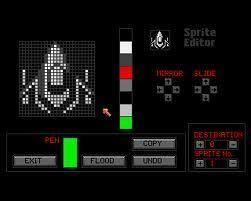 | ||
A game creation system (GCS) is a consumer-targeted game engine and a set of specialized design tools (and sometimes a light scripting language), engineered for the rapid iteration of user-derived video games. Examples include Novashell and Pie in the Sky.
Contents
Unlike more developer-oriented game engines, game creation systems promise an easy entry point for novice or hobbyist game designers, with often little to no coding required for simple behaviors. Although initially stigmatized, all-in-one game creation systems have gained some legitimacy with the central role of Unity, Construct, and GameMaker: Studio in the growth of the indie game development community. Currently the Independent Games Festival recognizes games produced with similar platforms.
Development history
Early game creation systems such as Broderbund's The Arcade Machine (1982), Pinball Construction Set (1983), ASCII's War Game Construction Kit (1983), Thunder Force Construction (1984), Adventure Construction Set (1984), Garry Kitchen's GameMaker (1985), Wargame Construction Set (1986), Shoot'Em-Up Construction Kit (1987), Mamirin / Dungeon Manjirou (1988), and Arcade Game Construction Kit (1988) appeared in the 1980s on home computers. 3D Construction Kit was released on the ZX Spectrum in 1991, and contained a full polygon-based world creation tool. Most of these early design frameworks are specific to one or another genre.
In 1990s, game creation systems for the IBM PC shifted both to the more general and the more specific. Whereas frameworks like RSD Game-Maker and Klik & Play attempted to accommodate any genre, communities grew around games like ZZT (later, MegaZeux) that permitted such extensive user modification that they essentially became de facto game creation systems. Pie in the Sky Software created a full on 2.5D first-person shooter creator out of an engine they previously used internally, which sold in three total versions until 2003.
Later in the mid-2000s, with the growth of the World Wide Web and social networking, programs like BlitzBasic and Multimedia Fusion headlined an explosion of interest both in indie games and in canned game design software. Whereas earlier game creation systems tend to err on the side of user friendly interfaces, 21st-century systems are often distinguished by extensive scripting languages that attempt to account for every possible user variable.
Tools
Several game creation systems include some of the following tools:
Scripting
The rise of game creation systems also saw a rise in the need for free form scripting languages with general purpose use. Some packages, such as Conitec's Gamestudio, include a more comprehensive scripting language under the surface to allow users more leeway in defining their games' behavior.
Usage
While most of the mainstream and popular game creation systems may be general-purpose, several exist solely for specific genres.
